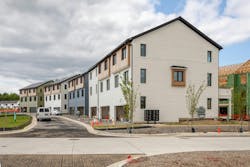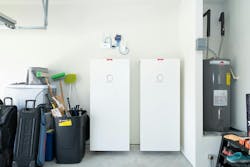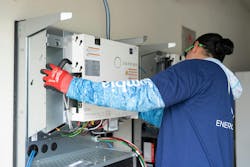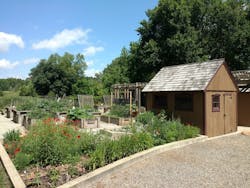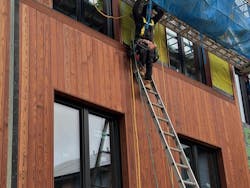New All-Electric Community in Michigan Prepped to Bring Virtual Power Plant to Life
In Ann Arbor, Michigan, developers Wednesday unveiled Veridian at County Farm—a new carbon-neutral community of 170 fully electric homes that blend affordability, resilience and cutting-edge energy design.
Thrive Collaborative, a local property developer focused on constructing life-enhancing communities, and sonnen, a battery and virtual power plant technology provider (whose name is stylized lower-case), made the announcement.
One of the first fossil fuel-free neighborhoods in the country, according to the developer, the newly constructed EV-ready homes are equipped with geothermal and electric heat pumps, all-electric appliances, at least 1.3 MW of rooftop solar and a sonnen intelligent battery.
Together, the technologies will form an integrated virtual power plant (VPP), or what Thrive and sonnen call a “clustered clean energy organism,” designed to eliminate the carbon footprint of each home.
“It’s more than net-zero—it’s a replicable model for how we can decarbonize our homes, stabilize the energy grid and reimagine what neighborhoods can be. We can be beneficial to the electric grid, rather than a drain on it,” said Matt Grocoff, founder of Thrive Collaborative.
VPP software coordinates and optimizes energy generation and use
Powered by advanced software, VPPs connect and coordinate distributed energy resources (DERs)—everything from rooftop solar panels and home batteries to electric vehicles and smart appliances. By aggregating tens, hundreds or even thousands of DERs into a single, dispatchable resource, VPPs can reduce demand or add supply during peak hours, keeping the grid resilient and balanced.
sonnen’s VPP software platform will “optimize each home’s energy systems, harmonizing solar energy generation, electric load and the broader community grid, effectively acting as a node within a greater virtual power plant,” Blake Richetta, CEO of sonnen explained to Microgrid Knowledge.
He noted that, on average, residents will pay less for their electricity. They’ll also have peace of mind thanks to the resilience provided by the battery system, which can power the home if there’s a power outage.
While the role Veridian’s VPP could play in the broader grid remains to be seen, it has the potential to offer several advanced grid services, including reducing the need for new grid infrastructure, helping manage energy demand, stabilizing grid frequency, improving overall grid reliability, balancing distributed energy resources and providing backup power reserves.
sonnen has been working with DTE Energy, the local utility, for the past four years to create a pilot agreement around the Veridian VPP. The company’s other VPPs, particularly its program with Rocky Mountain Power in Utah, are serving as benchmarks.
Richetta noted that after several meetings with DTE that also included the architect of Rocky Mountain Power’s VPP program and other key stakeholders, he’s hopeful they’ll be able to finalize the Veridian-DTE pilot agreement soon, and bring the VPP to life.
“This community is designed to be a true virtual power plant, which serves to enhance society’s greater energy system,” he said. It’s about grid integration, not grid defection.
In June, sonnen launched a similar residential VPP in an Edmonton master-planned community.
The community includes high-end and affordable homes
The median home listing price in Ann Arbor is around $550,000. In Veridian, townhomes start at about $650,000, with detached homes listed between $1.2 million and $1.5 million.
The community also includes 50 affordable rental units in the Grove at Veridian. Avalon Housing, a non-profit organization that pairs affordability with supportive services to help residents achieve housing stability and lead healthier, more productive lives, partnered with Thrive to develop the Grove.
“Climate resilience should never be a luxury,” Grocoff said. “Every resident deserves comfort, healthy air and energy security.”
He noted that more than 7,000 people applied for the first 20 affordable units, which the community released through a lottery. Eligible applicants were individuals and families earning less than 60% of the area’s median income.
Those selected are already moving in.
Washtenaw County’s Community Housing Prioritization system, which serves residents of the county who are homeless or at risk of homelessness, will fill the remaining 30 units.
The lower-cost townhomes and flats don’t have as many amenities as the high-end units, though they, too, are all-electric.
The Grove includes the Avalon Community Center. The center is part of Living Future’s Living Building Challenge Affordable Housing Pilot Project, which aims to ensure affordable housing is both accessible and healthy.
Thrive and Avalon are “currently exploring ways to take advantage of the non-profit direct pay tax credits to install solar [on the community center] to achieve net zero before the December 31 deadline,” Grocoff said.
A climate-conscious community
Located near downtown Ann Arbor, just three miles from the University of Michigan campus, the 14-acre community is within walking distance of multiple grocery stores, restaurants, shops and schools.
The adjacent County Farm Park spans 127 acres and has more than three miles of walking trails, nature programs, picnicking and playground areas, and a large community garden.
“Ann Arbor has the rare combination of political will, climate-conscious citizens and a municipal commitment to carbon neutrality,” Grocoff said, adding that it’s also where he calls home.
Last November, voters in this city of 120,000 overwhelmingly approved the creation of a sustainable energy utility (SEU).
The Ann Arbor SEU is an opt-in, community-owned program that will supplement the grid with 100% renewable power drawn from local solar and battery storage as well as networked geothermal systems installed at participating homes and businesses.
While plans for the utility are still in the early stages, the city expects it could deliver multiple services to help the community save energy, lower electricity costs and support the local grid. Microgrids, community solar and networked geothermal systems, such as the one installed at Veridian, are all on the table.
Veridian is not currently a part of the early startup phase of the SEU; however, Grocoff said the neighborhood directly supports its goals.
“Our solar-powered, solar-plus-battery infrastructure aligns seamlessly with the SEU’s clean, locally generated energy model—providing a real-world foundation for community-driven microgrids, resilience and distributed energy that the SEU aims to make available to all participating neighborhoods,” he said.
Bringing the vision to life
“One of the biggest challenges has been pioneering systems and partnerships that haven’t been done at this scale before—like integrating neighborhood-wide solar, storage, and geothermal and aligning them with utility regulations," Grocoff told Microgrid Knowledge.
He credited persistent collaboration with the city, utilities and community partners, as well as staying hyper-focused on their vision of creating a truly net-zero, people-centered neighborhood, for bringing the project to life.
“We didn’t ask what was possible. We asked what was necessary,” Grocoff said.
Both he and Richetta hope to scale the Veridian model, building more self-sufficient neighborhoods with integrated food, energy and water systems across the state.
“We wanted to show that meeting [climate] goals with net-zero energy, front porch-centered design, access to a farm stop grocery store and shared green space would be beautiful,” he added. “We could show the way to a new era of abundance!"
About the Author
Kathy Hitchens
Special Projects Editor
I work as a writer and special projects editor for Microgrid Knowledge. I have over 30 years of writing experience, working with a variety of companies in the renewable energy, electric vehicle and utility sector, as well as those in the entertainment, education, and financial industries. I have a BFA in Media Arts from the University of Arizona and a MBA from the University of Denver.
